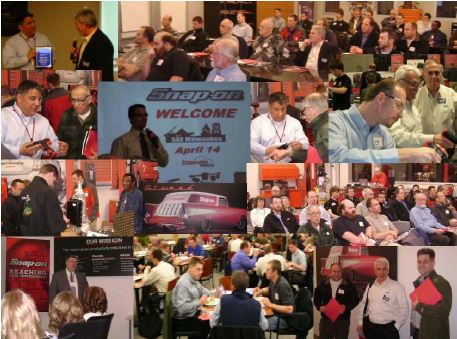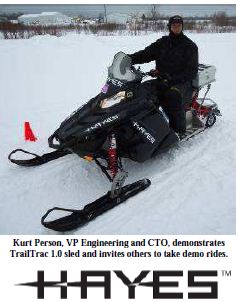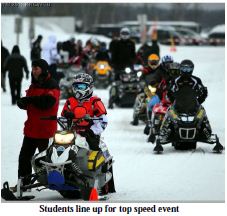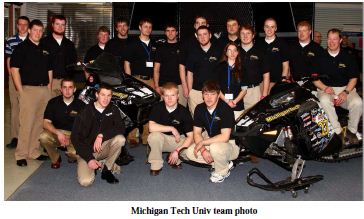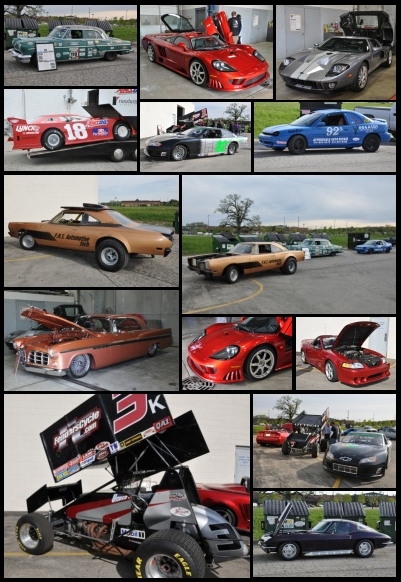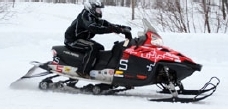
SAE’s Clean Snowmobile Challenge and UW Madison were both again successful! Congratulations to UW for capturing both titles, and our Michigan Tech team for taking second. “It came down to having a running sled the whole time,” said team captain Jacob Mauermann. “The warm weather made it difficult for everyone, so at the end of the day, it was about reliability as much as design.” The team focused on improving emissions in its internal combustion entry and on reducing noise in the battery-powered zero emissions snowmobile. “We built a brand-new zero emissions sled and switched to a direct drive belt,” said Mauermann, adding that the team tested the sled exhaustively before the competition.
Held at the University’s Keweenaw Research Center, the Clean Snowmobile Challenge is a collegiate design competition of the Society of Automotive Engineers. Engineering students from participating schools take a stock snowmobile and re-engineer it. Their aim: to reduce emissions and noise while maintaining or boosting performance. The Challenge also has a division for battery-powered sleds. The zero emissions category is sponsored by the National Science Foundation, which uses electric snowmobiles while conducting research in pristine arctic locations.

SAE’s Clean Snowmobile Challenge and UW Madison were both again successful! Congratulations to UW for capturing both titles, and our Michigan Tech team for taking second. “It came down to having a running sled the whole time,” said team captain Jacob Mauermann. “The warm weather made it difficult for everyone, so at the end of the day, it was about reliability as much as design.” The team focused on improving emissions in its internal combustion entry and on reducing noise in the battery-powered zero emissions snowmobile. “We built a brand-new zero emissions sled and switched to a direct drive belt,” said Mauermann, adding that the team tested the sled exhaustively before the competition.
Held at the University’s Keweenaw Research Center, the Clean Snowmobile Challenge is a collegiate design competition of the Society of Automotive Engineers. Engineering students from participating schools take a stock snowmobile and re-engineer it. Their aim: to reduce emissions and noise while maintaining or boosting performance. The Challenge also has a division for battery-powered sleds. The zero emissions category is sponsored by the National Science Foundation, which uses electric snowmobiles while conducting research in pristine arctic locations.
The University of Wisconsin-Madison’s internal combustion sled received the Gage Products Award for Best Fuel Economy, the AVL Award for Best Emissions, the Sensors Inc. Award for Lowest In-Service Emissions and the BlueRibbon Coalition Award for Most Practical Solution. Its battery-powered entry received the SAE Award for Best Design in the zero emissions category.
Michigan Tech’s snowmobile took second place in the internal combustion category, equaling last year’s finish. It also received the SAE Award for Best Design in the internal combustion category, the Land and Sea Award for Best Performance and the Altair Engineering Award for Design Simulation. “We did lots of design and analysis, and it paid off,” said team captain Josh Ball. “Everything we designed held up pretty well for us.”
Clarkson University’s zero emissions entry took second place in that category and also took the CH2M HILL Polar Service Range Event Award and the Keweenaw Research Center Draw Bar Pull Award.
The University of Idaho finished third in the internal combustion category, earning the International Engineering and Manufacturing (Woody’s) Award for Best Acceleration, the Polaris Industries Award for Best Handling and the DENSO Corporation Award for Best Ride.
The State University of New York at Buffalo finished fourth in the internal combustion category. The only diesel-powered sled in the Challenge, it took the PCB Group Award for Quietest Snowmobile, the Caterpillar Corporation Award for Innovation and the Aristo Catalysts Inc. Award for Most Improved Snowmobile.
Kettering University took fifth place in the internal combustion category.
McGill University finished third among the zero emissions sleds.
The University of Minnesota-Duluth received the Hawk Technology Safety Award.
The A&E Inc. Tools and Ken Cook Publications Award for Serviceability was given to the South Dakota School of Mines and Technology.
Newcomer North Dakota State University received the Rookie of the Challenge Award.
And the University of Wisconsin-Platteville team members were honored with the Bill Paddleford Founder’s Award for Most Sportsmanlike Conduct for the help they provided to North Dakota State’s team during its first year at the Challenge.
None of the Clean Snowmobile Challenge events had to be cancelled, despite an early spring thaw and temperatures that occasionally soared into the 60s. Saturday’s handling and acceleration events were held on a raised track that was assembled for the occasion. “We had guys picking up snow with a front-end loader and literally making a snow road,” said Jay Meldrum, co-director of the Challenge. “It’s amazing what they were able to do.”
William Predebon, chair of the mechanical engineering-engineering mechanics department and the Challenge’s other co-director, praised the efforts of the KRC staff in bringing the Challenge to a successful close. “No one else had any more snow than we did this year,” he said. “Without the efforts of these guys and without this facility, we couldn’t have pulled it off. They did a great job.”
Consider joining us next year, up at Houghton, MI. The Clean Snowmobile Challenge continues to grow each year in participation, as well as the value and significance of this initiative.
For details, videos and pics, go to http://www.mtukrc.org/snowmobile.htm
For the media release: http://www.mtu.edu/news/stories/2010/march/story24850.html
